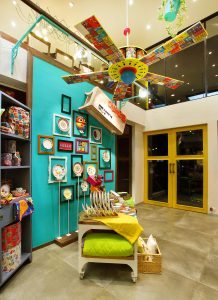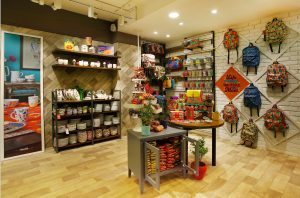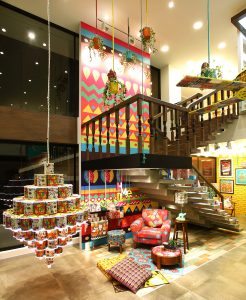 Isn’t it remarkable how the past is always with us? How objects, textures and things that were part of that past still surround us, but rather than haunt, they offer a feeling of comfort, security and warmth. Not many of us live in homes or apartments with exposed walls of aged bricks, nor do we walk on floors covered with ancient timber, yet when we enter a shop or café or bar that is enhanced by with those textures, we feel at home—as though we know this place and are happy to connect with the vintage store space.
Isn’t it remarkable how the past is always with us? How objects, textures and things that were part of that past still surround us, but rather than haunt, they offer a feeling of comfort, security and warmth. Not many of us live in homes or apartments with exposed walls of aged bricks, nor do we walk on floors covered with ancient timber, yet when we enter a shop or café or bar that is enhanced by with those textures, we feel at home—as though we know this place and are happy to connect with the vintage store space.
The bare brick wall, the lumber that was rescued from a collapsed or collapsing building and those strange looking “antique” objects that were once part of our grandparents or great-grandparents lives are now familiar friends as we, as a nation and as a global community, are more aware of the world’s fragile ecology. Today, architects, store designers and interior designers are saving as much of the past as they can, not only for the good it can do but for what it offers as material to build vintage store displays for a new audience that is fascinated by the past as well.
I relish designs that emphasize reuse and repurpose when it comes to fixtures, furniture and decoratives, as well as finishing materials. So many design elements and so many pieces of furniture are discarded—tossed out or destroyed—that are still usable and can still function effectively. They also add a special quality to the design be it a connection to the past and reinforcement of the brand identity.
 The “old” may add a humorous accent—a light touch—to a serious undertaking. An old armoire or scarred chest of drawers can be given a new coat of acrylic, water-based paint and lined with colorful wallpaper to become a featured fixture in a shop or as a window display. A lighting fixture from the 1930s adds a unique look as it hangs over a rustic farm table, which now serves as a focal displayer in a shop. Mixing old with new is not a recent concept. It has been around since “the old” was actually “the new.”
The “old” may add a humorous accent—a light touch—to a serious undertaking. An old armoire or scarred chest of drawers can be given a new coat of acrylic, water-based paint and lined with colorful wallpaper to become a featured fixture in a shop or as a window display. A lighting fixture from the 1930s adds a unique look as it hangs over a rustic farm table, which now serves as a focal displayer in a shop. Mixing old with new is not a recent concept. It has been around since “the old” was actually “the new.”
Especially for attention getting displays, the “old” can be used to compliment the “new.” Can you picture that old refinished and relined cupboard filled with a line of bright contemporary dishes. How about an ancient gas range or “antique” coal stove used to present the newest and shiniest of cookware? Old home appliances are not only curiosities but also attention getters. They set up a whole NOW & THEN thing that demands comparison. You probably have some of these “antiques” in your basement or attic or—even worse—in the back of your cabinets. Pull them out and dust them off but leave them in their cracked or scratched or blemished state. They will make your newer versions shine brighter.
 What qualifies as “old”? Almost anything that is not “new.” No matter how smart, stylish and sophisticated your shop may be, or maybe because it is so smart, stylish and sophisticated, something worn, torn or shredded can make such a big impression amidst all that is new and shiny and perfect. It can be the “irritant” that jolts or startles the visitor to see something you wanted to highlight. Old tea cozies and tea towels and grandma’s tea cups to set the scene for bright, brilliant tea kettles? Cans or boxes of food from another era or generation to contrast with sharp, stylish dinnerware? Use the old to make the new look even newer!
What qualifies as “old”? Almost anything that is not “new.” No matter how smart, stylish and sophisticated your shop may be, or maybe because it is so smart, stylish and sophisticated, something worn, torn or shredded can make such a big impression amidst all that is new and shiny and perfect. It can be the “irritant” that jolts or startles the visitor to see something you wanted to highlight. Old tea cozies and tea towels and grandma’s tea cups to set the scene for bright, brilliant tea kettles? Cans or boxes of food from another era or generation to contrast with sharp, stylish dinnerware? Use the old to make the new look even newer!
If you need a focal point or a specialty area highlighted, try using something old—like an “antique” piece of furniture to make a vintage store display. If all your fixtures and fittings are stainless steel, compliment all that shine with a rustic wood farm table or kitchen cabinet or—if you can find one—a vintage ice box left open to show off some contemporary merchandise inside on the tired shelves.
Use your imagination. Be creative. Look at and search for old pieces that are interesting, odd, unique, quaint and yet will serve as attention getters for your younger shoppers or “old friends” revisited to your older patrons. Making old new again with vintage store displays can be the way to make your brand user friendly to a wider market while also showing your “green” side by reusing, repurposing and refinishing things that might have gone into another landfill. There is much to gain and at very little or no cost. Enjoy—have fun and watch the smiles on your shoppers’ faces as they see old, familiar and bygone “friends” again.



